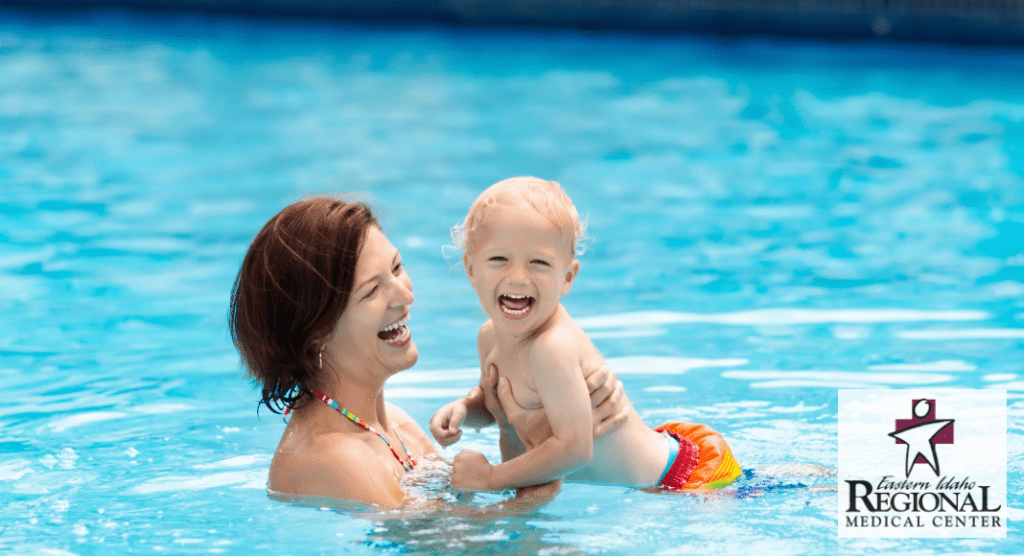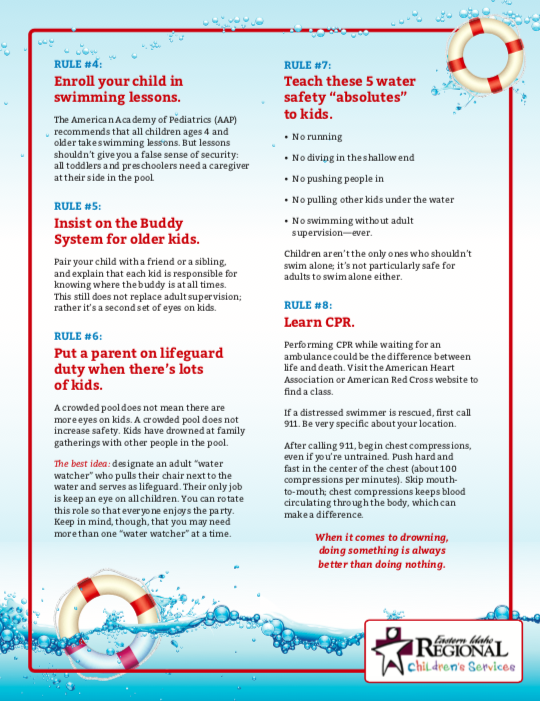Drowning accidents happen. And, they could happen to anyone. At any time. Drowning is THE #1 cause of accidental deaths for kids ages 1-4. So, as parents, following some simple water safety rules to keep kids safe around water should be at the top of our summer to-do lists.
Summer memories are made around the water. Chances are you think summer and an image of a pool, lake, ocean, or river come to mind. Let’s keep those memories happy – not tragically clouded by a drowning. These water safety rules will help keep those summer memories joyful!
Eastern Idaho Regional Medical Center Children Services has put together some amazing reminders for all parents and caregivers. Keep these in mind when around ANY water: lakes, rivers, pools, spas, baby pools, bathtub…ANY water.
8 Life-Saving Water Safety Rules
#1 :: Never take your eyes off your child when in or around the water.
Kids are fast and sneaky. We know it. It’s amazing how in 3 seconds a child can run across the room and dump a box of toys you just spent 10 minutes picking up. And in that same 3 seconds, they can run to the water. Drowning can happen in seconds. Stay close to both young, inexperienced swimmers and strong swimmers!
#2 :: Ignore your phone.
The call, text, or notification can wait. Having a phone nearby for an emergency is a great idea, but keep it put away so it’s not a distraction.
#3 :: Floaties, inflatable toys, rafts, pool noodles are not life jackets.
The safest floatation device is a well-fitting Coast Guard approved life jacket. There are so many great pool toys and floatation aides that can be fun and helpful for a child learning to swim. But, they should never replace constant supervision.
Remember to remove all toys from the water when you are finished so little ones don’t try to get in the water to play with them.
#4 :: Enroll your child in swimming lessons.
Swim lessons are a great way to build skills and confidence in your child. The Ameican Academy of Pediatrics recommends that all children 4 and older take lessons. But, don’t let their new ability give you a false sense of security – they still need eyes on them at all times.
#5 :: Insist on the Buddy System for older kids.
Assign older kids a buddy to stay with while swimming. The buddy system doesn’t replace adult supervision, encouraging kids to stick with and watch out for a friend or sibling is a great habit to start.
#6 :: Put a parent on lifeguard duty when there are lots of kids.
There is power in numbers, but sometimes large groups lead to the “someone is watching” mindset. The BEST idea is to designate “water watchers” that know their job is to watch the water while they are on duty.
#7 :: Teach these 5 water safety “absolutes” to kids.
- No running
- No diving in the end
- No pushing people in
- No pulling other kids underwater
- No swimming without adult supervision
These aren’t options – they are absolutely to be followed or no swimming. Teaching kids the danger of water is important and so is instilling safe habits that can prevent accidents.
#8 :: Learn CPR.
If a distressed swimmer is rescued, first call 911. Then, performing CPR could be the difference between life and death. Check out American Red Cross for info about classes around Idaho Falls. Even if untrained, begin chest compressions. Push hard and fast in the center of the chest (about 100 per minute).
These tips from EIRMC will save lives. Accidents can happen in an instant. Reminders are so important. Save, print, and share these rules all year long to keep our water memories full of joy and sunshine!
Download this EIRMC Water Safety Flier
A Must-Watch Video on CPR from EIRMC















